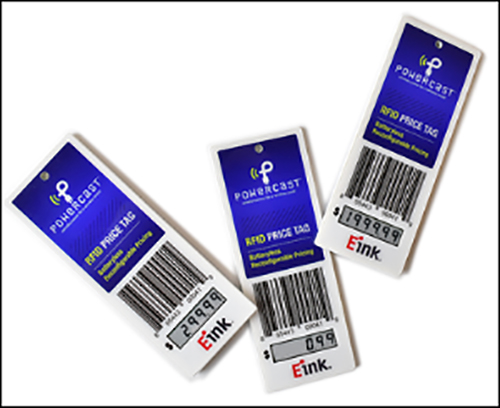Powercast released a battery-free energy-gathering RFID tag that enables RFID-based e-paper information updates, such as item price updates. The company is working with system integrators to develop its store solutions.
The "remote-powered" wireless charging price tag has a built-in UHF RFID transponder and electronic ink screen, as well as Powercast's PCC110 Powerharvester chip. Charles Greene, Powercast's chief operating officer and chief technology officer, said that when reading, tags can not only respond to readers, but also use RF-DC functions to collect energy.
Powercast Releases a Battery-Free Energy Harvesting RFID Tag
In 2017, Powercast released an RFID sensor tag called PCT100, which uses a reader's power supply to power sensors and transmit sensor data over UHF. The tag can have built-in temperature, humidity and light sensors.
Powercast's latest products target the retail market. Many retailers (especially large chain companies) often regularly and uniformly modify the price and other descriptive data on the label throughout the company. The headquarters set a new price, and other branches must jointly modify the price.
When using a paper label, the label needs to be reprinted and replaced manually. Electronic shelf labels are relatively expensive, and some of them also need to communicate with servers via data lines. In addition, some tags have built-in batteries and require regular battery replacement, which also requires a lot of work.
Using Powercast's battery-free price tag, employees only need a handheld reader that stores price information to fulfill these requirements. Stores can configure the software in a variety of ways, such as associating each unique ID number on a label with a specific product, so that the display price can be changed when the label is read. In addition, employees can select areas to change the price information for the area.
When the handheld device is within 2 meters of the tag, the tag begins to receive the RF signal and can then be converted to direct current. Then, the tag starts sending a unique ID number, and after the reader recognizes the tag, it starts sending command update price information.
Greene said that some stores began to study the use of fixed readers in the system. For example, some retailers have installed fixed readers in their facilities, and they can use existing facilities to update the label price. When using a fixed reader, the system can send data at a distance of more than 10 meters, but the data update time takes 45 seconds.
The solution also applies to applications other than retail, such as the medical industry. The user can use this tag to determine if the consumables on the shelf or drawer need to be replenished. In addition, Powercast will work with solution integrators to customize tags for different use cases.
Later this year, the company plans to launch a PowerSpot TX91503 transmitter that can send radio signals (headphones or game controllers) to the device to remotely power these devices.
